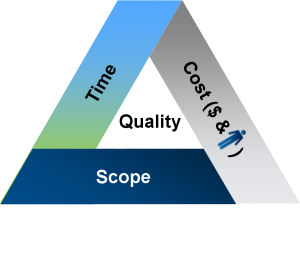Main menu
You are here
Project Management 101 - Lesson-01 : Basic Project Management Outline
Basic Project Management Outline

A successful Project Manager must simultaneously manage the four basic elements of a project: resources, time, money, and most importantly, scope. All these elements are interrelated. Each must be managed effectively. All must be managed together if the project, and the project manager, is to be a success.
-
Resources
People, equipment, material -
Time
Task durations, dependencies, critical path -
Money
Costs, contingencies, profit -
Scope
Project size, goals, requirements
Most literature on project management speaks of the need to manage and balance three elements: people, time, and money. However, the fourth element is the most important and it is the first and last task for a successful project manager. First and foremost you have to manage the project scope.
The project scope is the definition of what the project is supposed to accomplish and the budget (of time and money) that has been created to achieve these objectives. It is absolutely imperative that any change to the scope of the project have a matching change in budget, either time or resources. If the project scope is to build a building to house three widgets with a budget of $100,000 the project manager is expected to do that. However, if the scope is changed to a building for four widgets, the project manager must obtain an appropriate change in budgeted resources. If the budget is not adjusted, the smart project manager will avoid the change in scope.
Usually, scope changes occur in the form of "scope creep". Scope creep is the piling up of small changes that by themselves are manageable, but in agregate are significant. For example, the project callls for a building to be 80,000 square feet in size. The client wants to add a ten foot long, 4 foot wide awning over one bay door. That's a pretty minor change. Later the client wants to extend the awing 8 feet to cover the adjacent bay. Another minor change. Then it's a change to block the upwind side to the covered area to keep out the wind. Later, it's a request to block the other end to make the addition more symetrical. Eventually, the client asks for a ceiling under the awning, lights in the ceiling, electrical outlets, a water faucet for the workers, some sound-proofing, and a security camera. By now, the minor change has become a major addition. Make sure any requested change, no matter how small, is accompanied by approval for a change in budget or schedule or both.
You can not effectively manage the resources, time and money in a project unless you actively manage the project scope.
When you have the project scope clearly identified and associated to the timeline and budget, you can begin to manage the project resources. These include the people, equipment, and material needed to complete the project.

